
“I have dozens of photographs taken out my back door because I live in the most beautiful place in the world.” Location: Sengekontacket, 2013.
Contributor: Bonnie Stacy.
The photographs and stories gathered at the Martha’s Vineyard Mass. Memories Road Show are available online now for research.
Held at the Martha’s Vineyard Hebrew Center on October 25, 2015, the event was organized by the Vineyard Haven Public Library in association with the five other town libraries on the island. The event was made possible by additional support from the Massachusetts Cultural Council, Twin Oaks Inn, Mansion House on Martha’s Vineyard, and the Steamship Authority. Two dozen local volunteers collaborated with a team of UMass Boston staff members and “Roadies” from past Mass. Memories Road Shows to welcome nearly 100 adults and children with connections to the island.
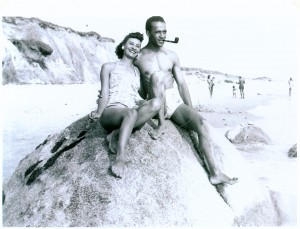
“My sister and her husband, Richard and Vivian Mitchell of East Orange and Morristown, New Jersey first came to Martha’s Vineyard in 1942. One of the young African American families who gave up the New Jersey shore and Jones Beach in New York for a love of Martha’s Vineyard. In spite of the 8-hour drive, a prefab cottage was built over many weekends, and the summer residence for three generations was set.” Pictured: Vivian Mitchell, Richard Mitchell. Contributor: Joseph Campbell.
Many participants shared photographs and stories of themselves and their families at home or at play around the island. Other individuals contributed memories of attending school concerts, theater performances, and other community gatherings. Life at work on the island– in fishing fleets, fire departments, public schools, and on the set of “Jaws” in 1974–is also documented in the collection. Several images document local businesses such as the S.M. Mayhew Co. store and C.B. Stark jewelers.
Several people brought materials documenting creative and artistic endeavors on Martha’s Vineyard over the decades. In addition, a significant number of items in the collection portray residents enjoying and exploring the natural beauty of the island landscape: playing on the beach, circumnavigating the island with friends and colleagues, or just taking in the view outside their doors.
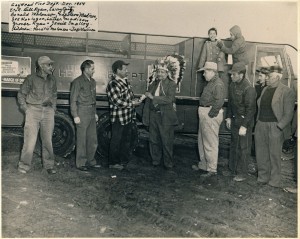
“This is a photo of the original Gayhead Fire Department in 1959. In 1978, I became the first female on the island to become a volunteer fireman. My father gave me his badge, number 16. In 1988 I became the first woman assistant fire chief on the island. The man in the headdress is Napoleon Madison, medicine man of the Wampanoag tribe in Gayhead. His son, Luther Madison, eventually became the next medicine man. Donald Malonson was the fire chief. Pictured, from back to front, left to right: Horation Malonson, my father Jeff Madison, Bill Ryan, Larry Spitz, Donald Malonson, Napoleon Madison, Joe Horiagon, Luther Madison, Grover Ryan, Jesse Smalley.” Contributor: Barbara Bassett.
The video interviews collected at this event are still being processed; a separate notice will be posted when they are available.
Browse the Martha’s Vineyard Mass. Memories Road Show collection.
The Mass. Memories Road Show is a statewide digital history project that documents people, places and events in Massachusetts history through family photographs and stories. In partnership with teams of local volunteers, we organize public events to scan family and community photographs and videotape “the stories behind the photos.” The images and videos are indexed and incorporated into an online educational database. Since its launch, the project has gathered more than 8,000 photographs and stories from across the state. It is supported in part by the Patricia C. Flaherty ’81 Endowed Fund at UMass Boston.
University Archives & Special Collections in the Joseph P. Healey Library at UMass Boston was established in 1981 as a repository to collect archival material in subject areas of interest to the university, as well as the records of the university itself. The mission and history of UMass Boston guide the collection policies of University Archives & Special Collections, with the university’s urban mission and strong support of community service reflected in the records of and related to urban planning, social action, alternative movements, community organizations, war and social consequence, and local history related to neighboring communities. To learn more, visit blogs.umb.edu/archives.
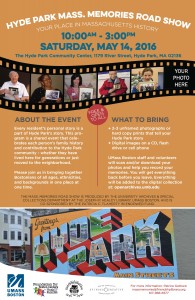 When: Saturday, May 14, 2016 | 10:00 am – 3:00 pm
When: Saturday, May 14, 2016 | 10:00 am – 3:00 pm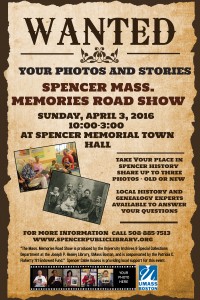




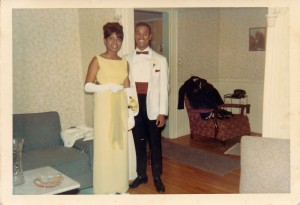
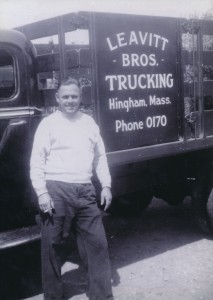
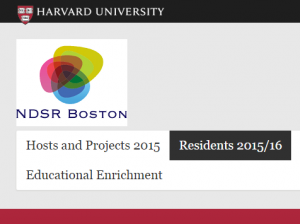 Guest post by Jeffrey Erickson
Guest post by Jeffrey Erickson The Mass. Memories Road Show (MMRS) is an ongoing community-based digital humanities project conducted by UMass Boston since 2004. The goal of the project is to collaborate with Massachusetts cities and towns to organize community-building events where images and stories that document the history of Massachusetts through the eyes of its residents are collected one town at a time. To learn more about the Mass. Memories Road Show project,
The Mass. Memories Road Show (MMRS) is an ongoing community-based digital humanities project conducted by UMass Boston since 2004. The goal of the project is to collaborate with Massachusetts cities and towns to organize community-building events where images and stories that document the history of Massachusetts through the eyes of its residents are collected one town at a time. To learn more about the Mass. Memories Road Show project,  So, why should you be interested in my project? The answer is two-fold:
So, why should you be interested in my project? The answer is two-fold: